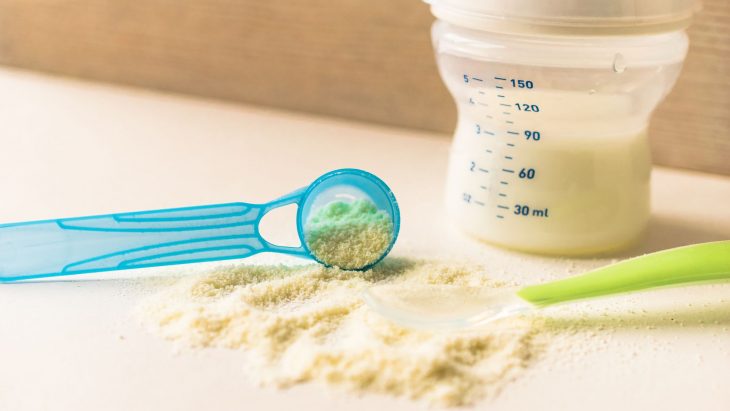If you’re wondering about the differences between Similac Advance vs Pro Advance you’re not alone. Similac has a gigantic line of baby formula products, all of which make their own claims to help your baby. In the midst of all of these formulas, it can get pretty difficult to know which one is the right one to choose for your little one. Don’t worry. We’ve got your back! In this article, we’ll be detailing the main differences between Similac Advance and Similac Pro Advance. We’ll also offer a few recommendations for the best Similac formula that might work best for you.

What Is Similac Advance Used For?
Similac Advance is typically used as a general yet high-quality formula that any baby could take.
When we say that Similac Advance is a “general” formula, what we mean is that it does not make specific claims that several other Similac products make. Some formulas claim to deal with lactose intolerance, food allergies, or other sensitivities that your baby may have. Similac Advance does not. Thus, this formula may not be the best pick for babies with allergies or intolerances.
In addition to being a generalized high-quality formula, Similac Advance also packs a punch in terms of benefits to your baby. The following are major advantages to choosing Similac Advance as your go-to formula for your little one.
DHA
Docosahexaenoic acid, otherwise known as DHA, is an omega-3 fatty acid naturally found in breast milk. In an attempt to mimic the benefits of breastmilk, Similac has added DHA to its formula. The role DHA plays in healthy growth and development includes the normal and healthy functioning of the brain.
Lutein
Another important addition that Similac has added to its Advanced formula is lutein. Lutein is an antioxidant found in breast milk. The presence of lutein usually increases depending on the amount of lutein consumed by the mother. This dietary carotenoid matures the eyes and brain. It can improve visual processing, memory, and learning in children and adults, alike.
Vitamin E
Vitamin E has been added to Similac Advance and helps with respiratory development as well as boosts the immune system. It also helps with neurodevelopment and improving cognition.
Iron-Fortified
Breast milk contains iron, although not very much. Similac has added iron to Similac Advance, making it an optimal choice for supporting the creation of hemoglobin necessary to carry oxygen to all parts of the body.
No Artificial Growth Hormones
As with all of Similac’s formulas, Similac Advance contains no growth hormones. Growth hormones are commonly found in the form of rBST. This is a hormone given to cows to increase the amount of milk the cow produces. Though Similac stresses there has been known evidence to show any difference between rBST-treated cows and non-rBST-treated cows, many parents love the fact that Similac does not contain these hormones.
Easy-to-Digest (For Some)
On the brand’s website, Similac makes the claim that Similac Advance is easier to digest than some other formulas. While this may be true for infants who can readily consume cow’s milk formula, it isn’t true for all. Speak with your doctor if you find that Similac Advance isn’t being tolerated well by your little one. It may be that your child is sensitive to the proteins found in cow’s milk. In this case, your doctor may suggest another formula with less lactose such as Similac Total Comfort.

What Is Similac Pro-Advance Used For?
Similac Pro Advance is used for much the same reasons that Similac Advance is used.
Similac Pro Advanced includes all of the aforementioned benefits that Advance has including the addition of DHA, lutein, Vitamin E, iron, non-rBST milk, and more.
Whats the Difference Between Similac Advance and Pro Advance?
Believe it or not, both Similac Advance and Pro Advance are nearly identical.
However, the difference between the two lies in differences in human milk oligosaccharides, otherwise known as HMO.
Let’s take a look at the ingredients of each to see how they stack up.
Similac Advance
- Nonfat Milk
- Lactose
- High Oleic Safflower Oil
- Whey Protein Concentrate
- Soy Oil
- Coconut Oil
- Galactooligosaccharides
- Less than 2% of: C. Cohnii Oil*
- M. Alpina Oil†
- Beta-Carotene
- Lutein
- Potassium Citrate
- Calcium Carbonate
- Ascorbic Acid
- Soy Lecithin
- Potassium Chloride
- Magnesium Chloride
- Ferrous Sulfate
- Choline Bitartrate
- Choline Chloride
- Ascorbyl Palmitate
- Salt
- Taurine
- Inositol
- Zinc Sulfate
- Mixed Tocopherols
- d-Alpha-Tocopheryl Acetate
- Niacinamide,
- Calcium Pantothenate
- L-Carnitine
- Vitamin A Palmitate
- Copper Sulfate
- Thiamine Hydrochloride
- Riboflavin
- Pyridoxine Hydrochloride
- Folic Acid
- Manganese Sulfate
- Phylloquinone
- Biotin
- Sodium Selenate
- Vitamin D3
- Vitamin B12
- Calcium Phosphate
- Potassium Phosphate
- Potassium Iodide
- Potassium Hydroxide
- Nucleotides (Adenosine 5’-Monophosphate, Cytidine 5’-Monophosphate, Disodium Guanosine 5’-Monophosphate, Disodium Uridine 5’-Monophosphate)
Similac Pro Advance
- Nonfat Milk
- Lactose
- High Oleic Safflower Oil
- Whey Protein Concentrate
- Soy Oil
- Coconut Oil
- Less than 2% of: Schizochytrium Sp. Oil
- M. Alpina Oil
- 2′-Fucosyllactose
- Short-chain Fructooligosaccharides
- Beta-Carotene
- Lutein
- Potassium Citrate
- Calcium Carbonate
- Ascorbic Acid
- Soy Lecithin
- Potassium Chloride
- Magnesium Chloride
- Ferrous Sulfate
- Choline Bitartrate
- Choline Chloride
- Ascorbyl Palmitate
- Salt
- Taurine, Inositol
- Zinc Sulfate
- Mixed Tocopherols
- d-Alpha-Tocopheryl Acetate
- Niacinamide
- Calcium Pantothenate
- L-Carnitine
- Vitamin A Palmitate
- Copper Sulfate
- Thiamine Hydrochloride
- Riboflavin
- Pyridoxine Hydrochloride
- Folic Acid, Manganese Sulfate
- Phylloquinone
- Biotin
- Sodium Selenate
- Vitamin D3
- Vitamin B12
- Calcium Phosphate
- Potassium Phosphate
- Potassium Iodide
- Potassium Hydroxide
- Nucleotides (Adenosine 5′-Monophosphate, Cytidine 5′-Monophosphate, Disodium Guanosine 5′-Monophosphate, Disodium Uridine 5′-Monophosphate).
As you read through the ingredients you likely can see that most ingredients are the same but that there are a few differences.
For example, in Similac Advance you’ll see the presence of galactooligosaccharides. These HMOs have been shown to have positive effects on babies. These include an increased number of stools in babies, increased good bacteria in a baby’s gut, and lowered pH of baby poo.
Similac Pro Advance, on the other hand, offers an HMO known as 2′-Fucosyllactose, or 2’-FL as it is frequently expressed. The addition of 2’-FL is seen as highly innovative, as it most closely mimics the oligosaccharides found in human breast milk. In breastfed infants, 2’-FL offers countless benefits. These include improved infant gut health and improved immunity.
Know that there are over 1500 types of oligosaccharides found in breast milk. However, the oligosaccharides found in baby formula were created in a lab. Because of this, there is much debate over whether or not these oligosaccharides actually have the same benefits. Studies so far are conflicting as some research states there is no actual benefit while others claim the benefits to be legit.
Another difference between Similac Advance vs Pro Advance is the use of GMOs. Similac Pro Advance uses non-GMO ingredients, whereas Similac Advance does not. This is important as some parents may prefer non-GMO ingredients in their infant’s formula so as to avoid the repercussions of introducing GMOs to their baby at such a young age.
So, what are some of the risks of babies being exposed to GMOs? Currently, the widely held belief is that GMOs do not, in fact, produce any harmful effect on babies, children, and adults. It should be noted, however, that studies are still being conducted to confirm whether or not this claim is true. There is some evidence that seems to link GMOs with autoimmune disorders, though this claim has not yet been entirely confirmed.
Which Is Better Similac Advance vs Pro Advance
In terms of which of these two very popular formulas wins out, the truth is that it depends on what you’re looking for.
For some, there is no clear distinction between the two formulas, as they seem to perform relatively the same. This is likely because the ingredients list for each is very similar, with the exception of differences in the addition of oligosaccharides.
Aside from these differences, remember that Similac Pro Advance does not include GMOs which can prove to be a very important factor for parents passionate about this issue. Remember also that Similac Pro Advance tends to be a bit more expensive than Similac Advance. This is likely due to the addition of 2’-FL and the inclusion of non-GMO ingredients.
All in all, whether or not Similac Advance or Pro Advance will work better for your baby will depend on what you desire for your child and how they react to it. Not every baby will tolerate every formula the same. Still, it is best that you always consult your doctor before making any switches. By abruptly changing your baby’s formula, you may end up doing more harm than good as frequent switches can sometimes upset a baby’s digestive system. They can end up having bad, rotten eggs smelling farts, for example.
Switching From Pro Advance to Advance
If you plan to switch from Pro Advance to Advance there are a few things to keep in mind.
Remember that Pro Advance contains 2′-FL oligosaccharides that most closely resemble those found in human breast milk. Pro Advance also contains non-GMO ingredients. By switching from Pro Advance to Advance, your baby’s body may end up missing these key ingredients and may not take to the switch well.
Having said that, the Pro Advance and Advance Similac formulas are very similar. Because of this, it is possible that you may make the switch from Pro to Advance and see no reaction from your little one at all. If no reaction to the switch is noted, then you can continue to feed your little one Similac Advance.
If, however, your little one seems to be reacting negatively to the switch, be sure to consult your doctor. He or she can give you tailored advice according to your baby’s stats and medical history that can inform your next course of action.
Note: You may also try mixing both Advance and Pro Advance formulas according to the package directions. This may make the transition from Pro Advance to Advance a bit gentler.

Other Similac Recommendations
As mentioned, it is always best that you consult your doctor before making changes to your baby’s formula routine. Having said that, it is good that you know the main differences between Similac formula types so that you can best select the formula that fits your baby’s needs.
In previous posts, we’ve compared Total Comfort with Pro Sensitive. We’ve also compared Pro Advance with Pro Sensitive. Be sure to look into each type of Similac formula available in your area to get a feel for which might be best suited for your baby.
The following are a few Similac recommendations you may wish to check out depending on your baby and their needs:
- Similac Pro Advance – Very Popular Similar to Breast Milk
- Similac Pro Sensitive – Gentler on the Stomach, Good For Lactose Intolerance
- Similac Pro Total Comfort- Gentlest Formula Yet, Great For Lactose Intolerance
- Similac Alimentum- Formulate for Babies With Food Allergies
Note: There are non-”Pro” versions of each formula marked as Pro. However, these formulas will not come fortified with 2’-FL and won’t contain non-GMO ingredients. All baby formula is subject to availability. Note that non-Pro baby formula will often come at a more affordable price.
Similac Advance vs Pro Advance: Not That Different
Though there are differences that exist between Similac Advance and Similac Pro Advance, be advised that the two aren’t that different. The differences between them rest in the use of GMO ingredients and also the use of 2’-FL HMO. You should choose either one that fits your preferences.
Remember, that if your baby suffers from tummy issues related to gas, fussiness, and discomfort, it is best to consult your doctor. There are plenty of other Similac formulas available that may suit your baby better than Similac Advance or Pro Advance. Be sure to do your research and follow up with your doctor before making major changes to your baby’s feeding habits.
We hope this has helped!
Similac Advance vs Pro Advance – FAQs
As long as you follow the manufacturer’s instructions for preparing the formula, mixing the two should be fine. Just don’t use more of either formula than the recommended amount combined. Mixing more than required may lead to an excess amount of nutrients. Mixing less may lead to malnourishment as your baby isn’t getting what they need to grow and develop.


Leave a Reply